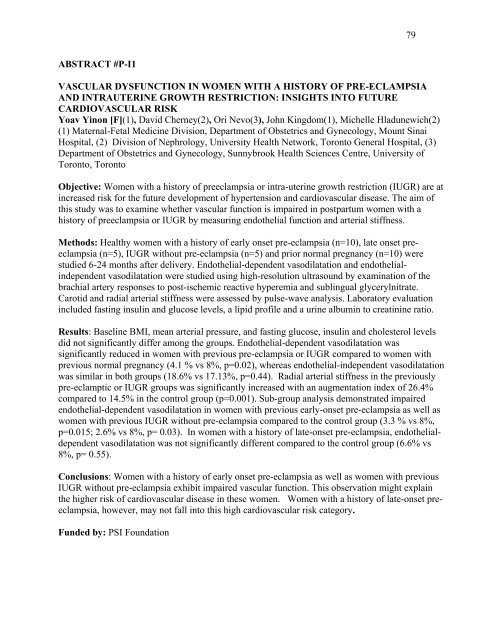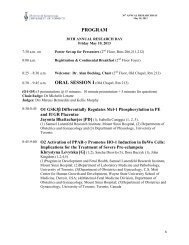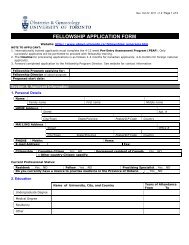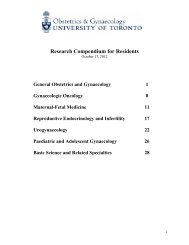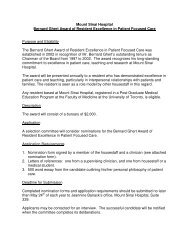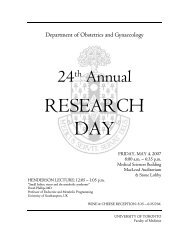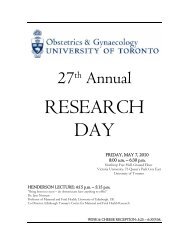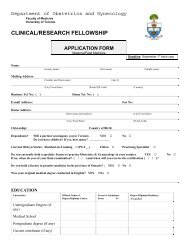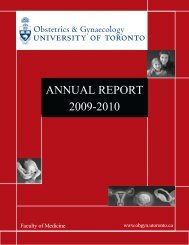research day - University of Toronto Department of Obstetrics and ...
research day - University of Toronto Department of Obstetrics and ...
research day - University of Toronto Department of Obstetrics and ...
Create successful ePaper yourself
Turn your PDF publications into a flip-book with our unique Google optimized e-Paper software.
79<br />
ABSTRACT #P-I1<br />
VASCULAR DYSFUNCTION IN WOMEN WITH A HISTORY OF PRE-ECLAMPSIA<br />
AND INTRAUTERINE GROWTH RESTRICTION: INSIGHTS INTO FUTURE<br />
CARDIOVASCULAR RISK<br />
Yoav Yinon [F](1), David Cherney(2), Ori Nevo(3), John Kingdom(1), Michelle Hladunewich(2)<br />
(1) Maternal-Fetal Medicine Division, <strong>Department</strong> <strong>of</strong> <strong>Obstetrics</strong> <strong>and</strong> Gynecology, Mount Sinai<br />
Hospital, (2) Division <strong>of</strong> Nephrology, <strong>University</strong> Health Network, <strong>Toronto</strong> General Hospital, (3)<br />
<strong>Department</strong> <strong>of</strong> <strong>Obstetrics</strong> <strong>and</strong> Gynecology, Sunnybrook Health Sciences Centre, <strong>University</strong> <strong>of</strong><br />
<strong>Toronto</strong>, <strong>Toronto</strong><br />
Objective: Women with a history <strong>of</strong> preeclampsia or intra-uterine growth restriction (IUGR) are at<br />
increased risk for the future development <strong>of</strong> hypertension <strong>and</strong> cardiovascular disease. The aim <strong>of</strong><br />
this study was to examine whether vascular function is impaired in postpartum women with a<br />
history <strong>of</strong> preeclampsia or IUGR by measuring endothelial function <strong>and</strong> arterial stiffness.<br />
Methods: Healthy women with a history <strong>of</strong> early onset pre-eclampsia (n=10), late onset preeclampsia<br />
(n=5), IUGR without pre-eclampsia (n=5) <strong>and</strong> prior normal pregnancy (n=10) were<br />
studied 6-24 months after delivery. Endothelial-dependent vasodilatation <strong>and</strong> endothelialindependent<br />
vasodilatation were studied using high-resolution ultrasound by examination <strong>of</strong> the<br />
brachial artery responses to post-ischemic reactive hyperemia <strong>and</strong> sublingual glycerylnitrate.<br />
Carotid <strong>and</strong> radial arterial stiffness were assessed by pulse-wave analysis. Laboratory evaluation<br />
included fasting insulin <strong>and</strong> glucose levels, a lipid pr<strong>of</strong>ile <strong>and</strong> a urine albumin to creatinine ratio.<br />
Results: Baseline BMI, mean arterial pressure, <strong>and</strong> fasting glucose, insulin <strong>and</strong> cholesterol levels<br />
did not significantly differ among the groups. Endothelial-dependent vasodilatation was<br />
significantly reduced in women with previous pre-eclampsia or IUGR compared to women with<br />
previous normal pregnancy (4.1 % vs 8%, p=0.02), whereas endothelial-independent vasodilatation<br />
was similar in both groups (18.6% vs 17.13%, p=0.44). Radial arterial stiffness in the previously<br />
pre-eclamptic or IUGR groups was significantly increased with an augmentation index <strong>of</strong> 26.4%<br />
compared to 14.5% in the control group (p=0.001). Sub-group analysis demonstrated impaired<br />
endothelial-dependent vasodilatation in women with previous early-onset pre-eclampsia as well as<br />
women with previous IUGR without pre-eclampsia compared to the control group (3.3 % vs 8%,<br />
p=0.015; 2.6% vs 8%, p= 0.03). In women with a history <strong>of</strong> late-onset pre-eclampsia, endothelialdependent<br />
vasodilatation was not significantly different compared to the control group (6.6% vs<br />
8%, p= 0.55).<br />
Conclusions: Women with a history <strong>of</strong> early onset pre-eclampsia as well as women with previous<br />
IUGR without pre-eclampsia exhibit impaired vascular function. This observation might explain<br />
the higher risk <strong>of</strong> cardiovascular disease in these women. Women with a history <strong>of</strong> late-onset preeclampsia,<br />
however, may not fall into this high cardiovascular risk category.<br />
Funded by: PSI Foundation


